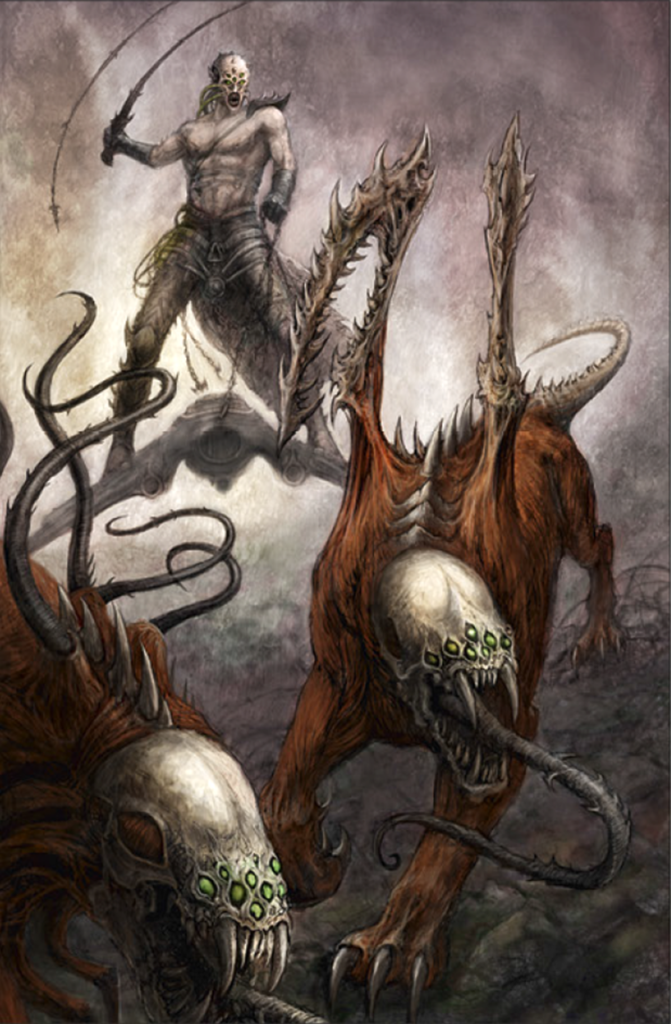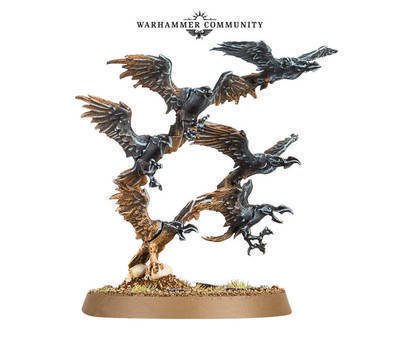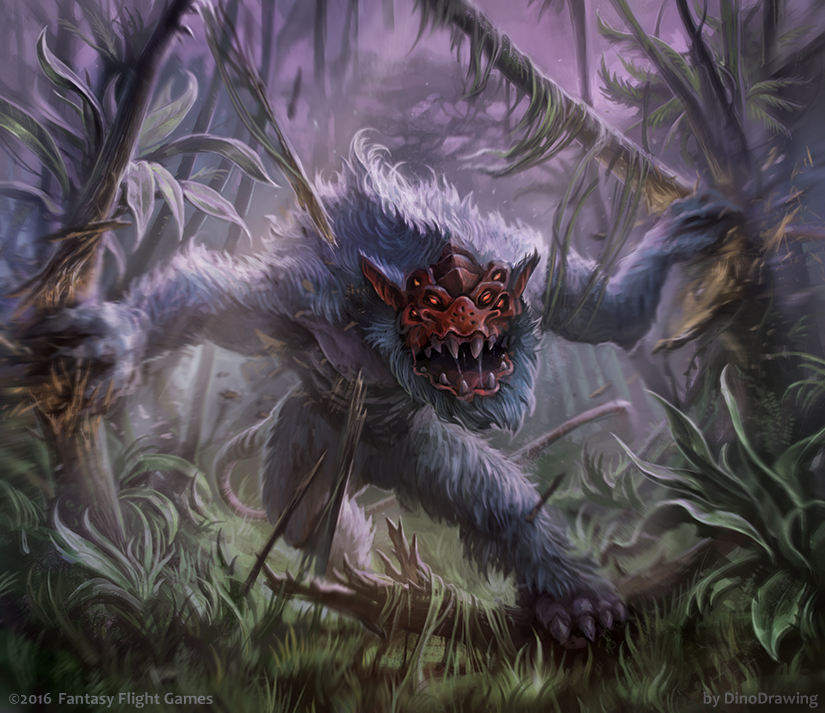When you think “beastly,” do you think “largely pointless and underwhelming even in their dedicated role”? If not, perhaps someone needs to notify Merriam-Webster about the inaccuracy. Click to read on, or check out the Tactics Corner for more reviews and strategies.

Overview
Although we’re listing them as a single entry here, the various Beasts that you can bring along are all technically different units- and, in fact, you cannot mix them together, though of course you’re free to bring units of each of them if you want. However, we’ll be grouping them all together here for a couple reasons, most importantly that none of them are really very good and thus it’s a bit of a waste of time to repeat the same handful of words about all of them over and over again. Note that all three types have abysmal leadership (Ld4) and no ability to fire ranged weapons at all.
Clawed Fiends are the “biggest” of the three types. They come with a 10″ movement, weapon skill 4+, strength and toughness five, four wounds, five attacks, and a 5+ save. They are available in squads from one to six models and 32pts apiece.
Khymerae are the middleweights of the beast options, with the same 10″ movement as Fiends but a better weapon skill (3+). Their other stats are much lower, however, with strength and toughness four, one wound, three attacks, and a 6+ save. At 10pts each, though, they are significantly cheaper, and available in squad sizes from two to seven models.
Razorwing Flocks (not to be confused with the Razorwing Jetfighter, mind you) are the most distinct of the three, having a 12″ movement with the Fly keyword as a significant point in their favor. However, the rest of their statline is pretty garbage- weapon skill 4+ is fine, but strength and toughness two is absolutely terrible, even with four wounds as compensation. Four attacks and no armor save also do not impress, and at twelve points per model (in squads of 3-6) they are rarely going to be seen.

Special Rules and Wargear
Each of the three beasts comes with its own melee weapon, although none of them are terribly impressive. Clawed Fiends attack with S+0 AP-1 Dmg2, making them the hardest-hitting of the crew. Khymerae get nothing of note, swinging with a perfectly ordinary melee weapon. Razorwings get AP-1, at least, though their awful strength limits this a lot.
Fiends and Khymerae also have an extra minor rule they each get. Clawed Fiends get Berserk Rage, which gives them +1 attack once they’re below their starting wounds. Khymerae get Otherworldly, which gives them a 5++ save. Neither are huge boosts, but they offer at least something additional.
Uses
Unfortunately, all three of the beasts are extremely underwhelming. While their basic statlines are not unusable, their lack of most of the defining special abilities for Drukhari as well as their inability to benefit from Obsessions is a major strike against them, as it denies access to a lot of useful special rules.
They also suffer from being quite fragile for their cost, in part due to lacking the special rules that other Drukhari benefit from. A Clawed Fiend, for example, is 32pts for four T5/5+ wounds- or in other words, it takes about fourteen Heavy Bolter shots to drop it. However, a squad of five Kabalite Warriors (30pts) has almost identical durability against the same gun, but occupies a troop slot, comes with guns, and actually has more attacks (albeit with worse stats.) And needless to say, the Fiend is comically more vulnerable to Lascannons, Autocannons, and other multidamage weapons, virtually all of which will tear it apart in short order. Similarly, Khymerae have a roughly equivalent durability to Warriors on a model-for-model basis as Kabalites… but cost half again as much as them and lack the aforementioned options. Razorwing Flocks, who are wounded on 3s by Lasguns of all things, need hardly even be discussed. Even comparing the three of them to Wyches turns out poorly, as it happens that the 6++/4++ that the gladiators carry is actually very useful when attempting to get into close combat with any degree of effectiveness, especially combined with Power From Pain.
We should also note that these models are not Infantry, and thus will struggle to move through ruins as well as lacking many of the benefits of cover that might otherwise help them. (They are, at least, not cavalry and thus can scale the upper levels of such structures, but have no special permission to pass through them.) This can be a critical weakness for assault units, as hiding behind large pieces of terrain and then moving out to pounce is a very standard strategy for such units- and being unable to do so must be seen as a huge weakness in virtually any format. Razorwing Flocks, however, can largely bypass this thanks to their Fly keyword, which gives them significantly higher mobility than the others despite only having a marginally higher movement value.
The Razorwing, in fact, is the only one of the three that has any chance of being useful in a competitive list. I will emphasize the word chance here, as I don’t think they are currently at all useful, but I can at least envision scenarios where you might want them. The Razorwing has an extremely weird niche in that it is cheap-ish, comes on a big base, has a bunch of wounds to soak up damage, and has the Fly keyword- in otherwords, all the ingredients for a perfect screening unit. Indeed, it’s seen some sporadic use this way in the past, but it’s been some time since it’s seen such play and I’m not expecting it will come back particularly soon, although the potential does still exist. Drukhari aren’t an army that often needs dedicated screening units, especially because its transports and other vehicles can often do a pretty decent job of it themselves, but in metas where the need arises (or potentially when allying into other armies), it is at least something that the unit can accomplish.

Countering
All three Beast units are pretty easy to get rid of with the basic firepower that almost any army will bring- S5+ weapons of any sort will devastate them, especially ones with multiple damage. They are vaguely fast, but not exceptionally so and even the most casually competent of countercharge units should be able to easily break them if they get into your lines.
Final Thoughts
The beasts, although very cool conceptually, are a real mess from a mechanical perspective and showcase some of the problems with designing units from an entirely top-down perspective. There are very valid reasons why, from in-universe, they have the stats and abilities they have- and why they lack other ones, but the result is a unit that is grossly subpar and play-wise very uninspiring, not living up to its descriptions at all. With a little more flexibility it would be easy to justify some changes or reconceptualize the unit to be a bit more useful, but sadly that is very rarely the way GW operates, even at the best of times.
As always, remember that you can get your wargaming supplies at great discounts from the Frontline Gaming store, whether you’re looking to expand an existing army or start a new one.


Not that it matters much, but having the Beast Master review in here would have helped. Now, they don’t add much but they do add something. They help Beasts with LD and have stratagem and modifiers to make Beasts more effective. I get that Beasts are not a competitive choice right now but I think at least fleshing out the review and making it as complete as possible would help everyone who uses these reviews when contemplating units and such. No FOC slot mention either. Even with bad units I still think it is right to give ALL of the information about them other than “they suck, don’t take them, etc.”
I don’t wish Beasts were in the same spot they were 6 or 7 years ago as being THAT good, but I think they need to have a place. They can fill a niche that DE don’t have and that is a fast, CC unit that doesn’t require 250pts or a transport to hope and pray make it across the board. They can make simple changes to them to make them viable.
As they are now, they are not a competitive choice even with Beast Master support. If they could be targeted with more strats or effected by Obsessions or PfP we would have a unit that actually could do some nice things.
I look forward to the next article.
The FoC slot is called out in the title of the review. Since it has essentially no relevance beyond that- and in fact beasts generally do not take up a FoC slot at all- I didn’t bother further discussing it. Beastmasters were discussed in their own article, because they are significantly different from the three beast units.
The problem with giving “all the information” is that you always have to draw a line somewhere. Could I have talked about the interaction of the Beastmaster’s buff and strat with the units? Yes, I could’ve- and the end result would still be “they’re not very good and you shouldn’t take them.” For that matter, I could’ve also talked about the effect of the other Drukhari stratagems on them- which in many cases is “they are subpar uses of the strat or outright prohibited from being targeted by them.” I could’ve expanded further by discussing their role in Aeldari armies at large- which, again, would’ve been “they don’t have one because they are not good.”
I generally keep my reviews of the bad units short unless their badness illuminates something interesting about the game design or codex. Beasts are neither good not interesting, so they got a short article- which I am sorry for, but there is a limit to how many times I can copy-paste the same text about how they cost too much, don’t do their job, and have no special abilities. We’ll be back to reviewing good units again next week with Grotesques, but for a unit like this there’s just not much I can say.
That was the answer I was expecting from you. Ok thanks for the “review.” Hopefully the next article is better and goes in depth and gives a real and whole review of the unit. It will be hard to mess up Grotesques, so hopefully they get the review they deserve.
@Yeeman I’m really not sure what you’re expecting from Abusepuppy here.
He could mention the Beastmaster here but a) he already gave it its own review and b) it doesn’t change anything. All it adds is a Ld bonus that would embarrass Grots and a worthless aura (to add to Drukhari’s collection of worthless auras).
Point being, it doesn’t change anything about how Beasts actually play on the table. It doesn’t remove any of their issues, nor does it add any new dynamics. Hell, it’s not even optional so you’re going to have the damn thing whether you want it or not.
In terms of strategy/tactics, there really isn’t much to discuss on that front either. The Drukhari codex has abysmal synergy, with each of the subfactions refusing to share buffs between one another. And in spite of technically being Cult units, the Beasts don’t actually benefit from Cult auras or Obsessions, so there’s nothing to discuss there either.
There’s, what, one stratagem unique to Beasts? And, as with the Beastmaster, it doesn’t actually change their dynamic at all. Use it to help guarantee some beast charges. That’s all you can really say about it.
I suppose he could suggest a Ynnari army with 36 Razorwing Flocks and The Yncarne with Shield of ynnead to give them all a 5++/6+++. Could be a laugh if your opponent fails to dispel it? But aside from a few gimmicks like that (which involve looking outside the actual Drukhari codex), there’s really not much you can say about Beasts. There are so few options and so little synergy involved that they’re little more than point&click units, and poor ones at that.
What factors do you feel the article left out that were important? What synergies or roles do you think were missing in terms of discussion, specifically?